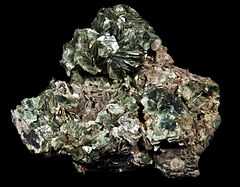Zinnwaldite
| Zinnwaldite | |
|---|---|
 | |
| General | |
| Category | Phyllosilicate mineral |
| Formula (repeating unit) | KLiFeAl(AlSi3)O10(OH,F)2 |
| Crystal symmetry | Monoclinic Point Group: 2/m |
| Unit cell | a = 5.29 Å, b = 9.14 Å, c = 10.09 Å: β = 100.83° |
| Identification | |
| Color | Gray-brown, yellow-brown, pale violet, dark green, color zoning common |
| Crystal habit | Well-formed short prismatic or tabular crystals, pseudohexagonal, in rosettes or fan-shaped groups; lamellar or scaly aggregates; disseminated. |
| Crystal system | Monoclinic - Prismatic |
| Twinning | On composition plane {001}, twin axis [310] |
| Cleavage | Perfect basal {001} |
| Fracture | Uneven |
| Tenacity | Laminae °exible, elastic |
| Mohs scale hardness | 3.5 - 4.0 |
| Luster | Pearly to vitreous |
| Streak | White |
| Diaphaneity | Transparent to translucent |
| Specific gravity | 2.9 - 3.1 |
| Optical properties | Biaxial (-) |
| Refractive index | nα = 1.565 - 1.625 nβ = 1.605 - 1.675 nγ = 1.605 - 1.675 |
| Birefringence | 0.040 - 0.050 |
| Pleochroism | Distinct, X = colorless to yellow-brown; Y = gray-brown; Z = colorless to gray-brown |
| 2V angle | 0 - 40° |
| References | [1][2][3] |
Zinnwaldite, KLiFeAl(AlSi3)O10(OH,F)2, potassium lithium iron aluminium silicate hydroxide fluoride is a silicate mineral in the mica group. The IMA status is as a series between siderophyllite (KFe2Al(Al2Si2)O10(F,OH)2) and polylithionite (KLi2AlSi4O10(F,OH)2) and not considered a valid mineral species.[3]
Name and discovery
It was first described in 1845 in Zinnwald/Cinovec on the German-Czech Republic border.[3]
Occurrence
It occurs in greisens, pegmatite, and quartz veins often associated with tin ore deposits. It is commonly associated with topaz, cassiterite, wolframite, lepidolite, spodumene, beryl, tourmaline, and fluorite.[1]